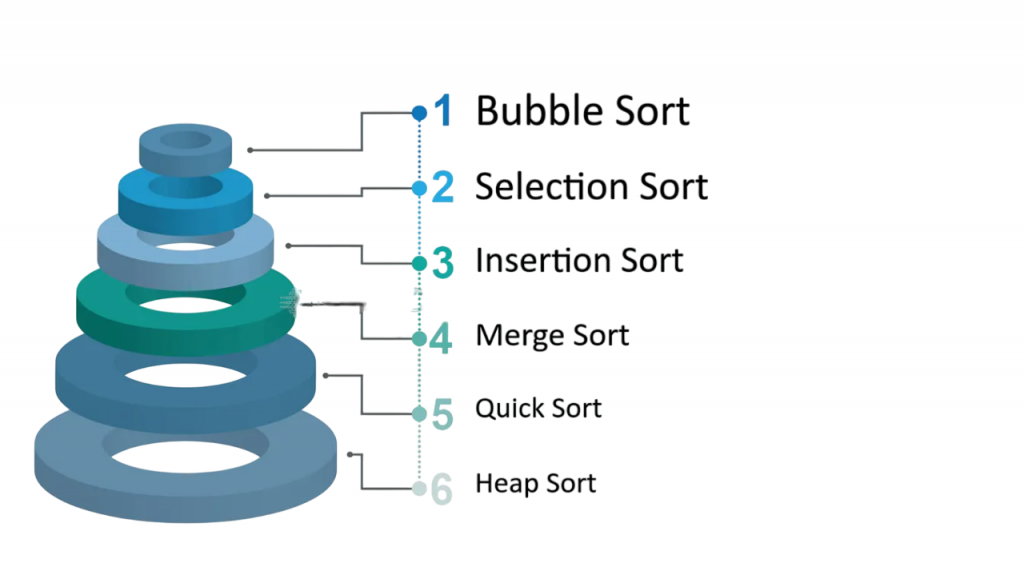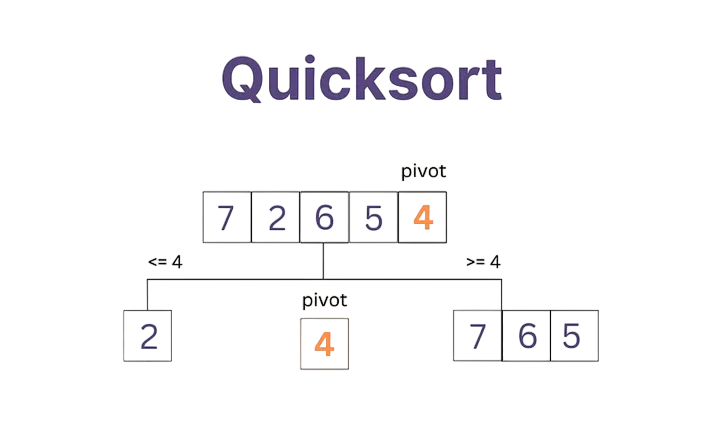
- Introduction to Sorting
- Types of Sorting Algorithms
- Bubble Sort
- Insertion Sort
- Merge Sort
- Quick Sort
- Heap Sort
- Conclusion
Introduction to Sorting
Sorting in Data Structure is one of the most fundamental operations in computer science and programming. It involves arranging data in a specific order, typically ascending or descending. Whether sorting numbers, strings, or records, having data in a predictable order allows for faster search, analysis, and display. Sorting algorithms are essential tools used in databases, search engines, operating systems, and more. Understanding sorting algorithms is critical for every developer, as they are commonly asked in coding interviews and used in real-world applications. Full Stack Training This guide dives deep into various types of sorting algorithms, comparing their performance, stability, and use cases. Sorting is a fundamental concept in data structures and algorithms that involves arranging data in a specific order, typically ascending or descending. It plays a crucial role in improving the efficiency of operations like searching, merging, and data representation. For example, binary search only works on sorted data, making sorting a prerequisite in many algorithms. There are various types of sorting techniques, each with its own use cases and performance characteristics. Common sorting algorithms include Bubble Sort, Selection Sort, Insertion Sort, Merge Sort, Quick Sort, and Heap Sort. These algorithms differ in terms of time complexity, space complexity, and stability. Sorting algorithms are generally categorized into two types: comparison-based (e.g., Quick Sort, Merge Sort) and non-comparison-based (e.g., Counting Sort, Radix Sort). Choosing the right sorting algorithm depends on factors like the size of the data, whether the data is partially sorted, and the need for algorithm stability Kruskal Algorithm in DAA. Understanding sorting is essential for building efficient software and solving complex computational problems. It not only helps optimize performance but also deepens the understanding of algorithmic thinking and data manipulation.
Interested in Obtaining Your Full stack Certificate? View The Full Stack Developer Course Offered By ACTE Right Now!
Types of Sorting Algorithms
Comparison-Based Sorting:
These algorithms compare elements to determine their order.
- Bubble Sort: Repeatedly swaps adjacent elements if they are in the wrong order. Simple but inefficient (O(n²)).
- Selection Sort: Repeatedly selects the minimum (or maximum) and places it in order. O(n²) time complexity.
- Insertion Sort: Builds the final sorted array one item at a time. StringBuilder Efficient for small or nearly sorted data.
- Merge Sort: Divide and conquer algorithm. Stable and efficient: O(n log n).
- Quick Sort: Divide and conquer; pick a pivot to partition array. Very fast in practice: average O(n log n).
- Heap Sort: Based on binary heap data structure. O(n log n), not stable.
- Counting Sort: Counts occurrences; O(n + k). Only for non-negative integers.
- Radix Sort: Sorts digit by digit (or bit by bit). O(nk), where k is digit length.
- Bucket Sort: Distributes elements into buckets, then sorts each. Best for uniformly distributed data.

Non-Comparison-Based Sorting:
These do not compare elements; good for integers or fixed-length data.
Bubble Sort
Bubble Sort is a basic algorithm suitable for educational purposes and small datasets. It repeatedly steps through the list, compares adjacent elements, and swaps them if they are in the wrong order. Bubble Sort is one of the simplest sorting algorithms in computer science. It works by repeatedly comparing adjacent elements in an array and swapping them if they are in the wrong order. This process continues through multiple passes until the entire array is sorted. With each pass, Pointers in C the largest unsorted element “bubbles up” to its correct position at the end of the list. Although easy to understand and implement, Bubble Sort is not efficient for large datasets. It has a worst-case and average-case time complexity of O(n²), where n is the number of elements. This makes it much slower compared to more advanced sorting algorithms like Merge Sort or Quick Sort. However, Bubble Sort can be optimized slightly by stopping early if no swaps are made during a pass, indicating that the list is already sorted. Due to its simplicity, Bubble Sort is often used for educational purposes to introduce the concept of sorting algorithms, but it is rarely used in practical applications where performance is important.
Insertion Sort
- Simple and intuitive algorithm that builds the sorted array one element at a time.
- Works by taking one element from the input data and inserting it into the correct position within the already sorted part of the array.
- Efficient for small or nearly sorted datasets because it minimizes the number of comparisons and shifts.
- Has a time complexity of O(n²) in the worst and average cases, Full Stack Training where n is the number of elements.
- Performs best with nearly sorted or small arrays, with a best-case time complexity of O(n) when the array is already sorted.
- Stable sorting algorithm, meaning it preserves the relative order of equal elements. Requires no additional memory (in-place sorting), so space complexity is O(1).
- Commonly used in practice for online sorting (sorting data as it arrives) and in hybrid sorting algorithms like TimSort.
- Heap Sort is a comparison-based sorting algorithm that uses a binary heap data structure.
- It works by first building a max heap (or min heap) from the input data, where the largest element is at the root.
- The root element (maximum) is then swapped with the last element of the heap, Fibonacci Series in Python and the heap size is reduced by one.
- The heap is then heapified again to maintain the max heap property for the reduced heap.
- This process is repeated until all elements are extracted from the heap, resulting in a sorted array.
- Heap Sort has a consistent time complexity of O(n log n) for best, average, and worst cases.
- is an in-place sorting algorithm, requiring only a constant amount of extra space (O(1)).
- Heap Sort is not stable, meaning it may change the relative order of equal elements during sorting.
Gain Your Master’s Certification in Full Stack Developer by Enrolling in Our Full Stack Developer Master Program Training Course Now!
Merge Sort
Merge Sort is a highly efficient, comparison-based sorting algorithm that follows the divide-and-conquer paradigm. It works by recursively dividing the array into two halves until each sub-array contains a single element or is empty, which is inherently sorted. Then, it merges these smaller sorted arrays step-by-step to produce larger sorted arrays until the entire array is merged and sorted. Because it divides the problem into smaller sub-problems, Merge Sort guarantees a consistent performance with a time complexity Linux Operating System of O(n log n), making it much faster than simple algorithms like Bubble Sort or Insertion Sort, especially for large datasets. Merge Sort is also a stable sorting algorithm, preserving the order of equal elements, which is important in many applications. However, one downside is that it requires additional memory proportional to the size of the array, due to the extra space needed during the merging process. Despite this, Merge Sort is widely used in scenarios where predictable and reliable sorting speed is critical, such as in external sorting for large files or complex data structures.
Quick Sort
Quick Sort is a popular and efficient sorting algorithm that also uses the divide-and-conquer approach. It works by selecting a special element called the “pivot” and partitioning the array into two sub-arrays: elements less than the pivot and elements greater than the pivot. The algorithm then recursively applies the same process to these sub-arrays until the entire array is sorted React Hooks .

Quick Sort is known for its excellent average-case performance, with a time complexity of O(n log n), making it faster than simpler sorting methods for large datasets. However, its worst-case time complexity is O(n²), which can occur if the pivot is poorly chosen (for example, always picking the smallest or largest element). To avoid this, various pivot selection techniques such as random pivoting or the median-of-three method are used. Quick Sort is generally an in-place sorting algorithm, requiring only a small amount of extra memory. It is not a stable sort, meaning it may change the relative order of equal elements. Despite this, Quick Sort remains one Prim’s Algorithm Explanation of the most widely used sorting algorithms in practice due to its speed and efficiency.
Are You Preparing for Full stack Jobs? Check Out ACTE’s Full Stack Developer Interview Questions and Answers to Boost Your Preparation!
Heap Sort
Conclusion
Sorting algorithms are fundamental tools in computer science that organize data efficiently for easier access and processing. Different algorithms offer various trade-offs in terms of speed, memory usage, and stability. While simple algorithms like Bubble Sort and Insertion Sort are easy to understand and useful for small or nearly sorted data, Sorting in Data Structure advanced algorithms such as Quick Sort Full Stack Training, Merge Sort, and Heap Sort provide much better performance for large datasets. Choosing the right sorting algorithm depends on the specific requirements of the problem, including data size, order, and whether stability is needed. Mastering sorting algorithms not only enhances programming skills but also deepens the understanding of algorithmic thinking and problem-solving.





